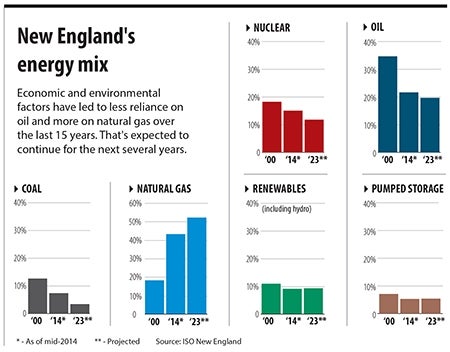Massachusetts and New England have brought themselves to a crossroads when it comes to the region’s energy needs.
Government incentives have ushered in a greater use of renewable forms of energy, such as solar and wind, and now, there is a pressing need to broaden pipeline capacity for natural gas, the region’s dominant energy source. Despite the progress made in growing the use of alternatives, energy costs in the region remain high, and we pay the highest electricity costs in the continental United States, more than 70 percent above the national average.
As five of New England’s six governors prepared to meet last week in Connecticut to discuss regional energy resources, it’s important that they reaffirm a regional commitment to solving energy problems that came out of a similar meeting in 2013; that is, to invest in more energy efficiency, renewables, natural gas pipelines and electric transmission. At the same time, some of the oldest power plants in southern New England have ceased operations or will by 2018, erasing more than 3,500 megawatts of oil-, coal- and nuclear-generated capacity. While we’re abandoning the oldest, least efficient and most environmentally unfriendly energy-generation sites, we don’t have a replacement plan to fill in that generating capacity at the rate that we’re shutting down older plants.
In Massachusetts, solar energy has already experienced tremendous growth over the last five years. It’s difficult to drive for an hour and not see an array of solar panels, either on the roof of a home, a business or in the form of a large ground installation.
The Massachusetts Department of Transportation, for one, recognizes the potential of solar and has leased an unused piece of land at Exit 13 on the westbound side of the Massachusetts Turnpike on the Framingham-Natick line to Framingham renewable energy firm Ameresco to build a solar farm. According to a recent report on WBZ TV, that will produce enough energy to power 1,300 homes. Ameresco will build other roadside solar farms around the state, and MassDOT will buy the electricity at less than half of its current costs, the report said, saving the state $15 million. This kind of low-impact, high-return project makes sense for the state on many levels, and there should be more of it in the coming years.
And, of course, there’s the added benefit of using less oil and natural gas that would otherwise be generated when this kind of renewable project gets off the ground.
What’s the next chapter in New England’s energy story?
It appears to be a combination of more solar and wind power and more natural gas pipeline capacity, along with the addition of imported hydroelectric power from Canada. Two years ago, five New England states — all but New Hampshire — announced an effort to explore the importing of more hydropower from Canada. Gov. Charlie Baker is a proponent of such an effort.
But right now, New England must prioritize the building of another pipeline that will bring in more natural gas from Pennsylvania and New York.
The pipeline proposed to run through Southern New Hampshire deserves full consideration. Failure to bring one online sets up the region for unnecessary spikes in natural gas prices, something that must be avoided given that fuel’s dominant position in the region’s energy mix and the abundant supply.
A six-state energy strategy is a more complex undertaking than one state going it alone. But all of the New England states are united by common issues, and that provides a solid foundation for charting a course for our energy future.
Here’s hoping that the governors make real progress on this critical issue. n

